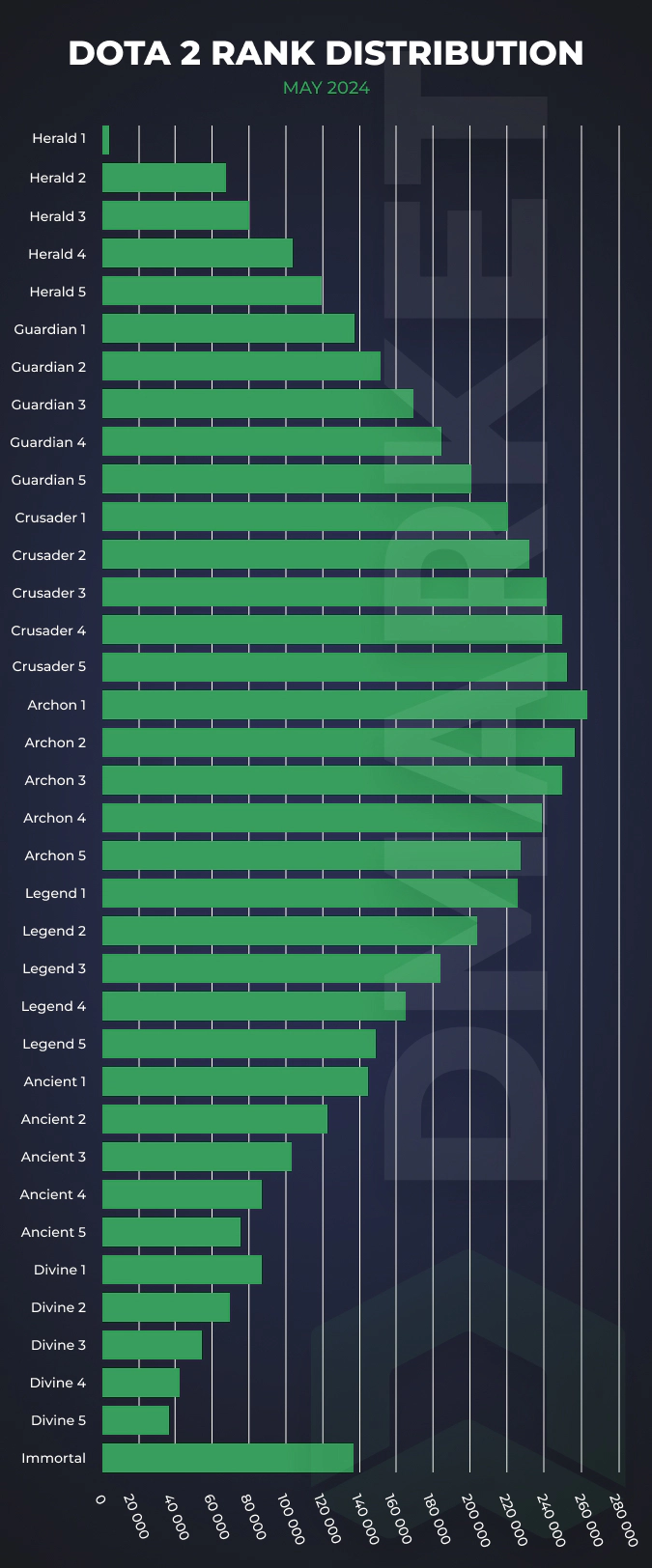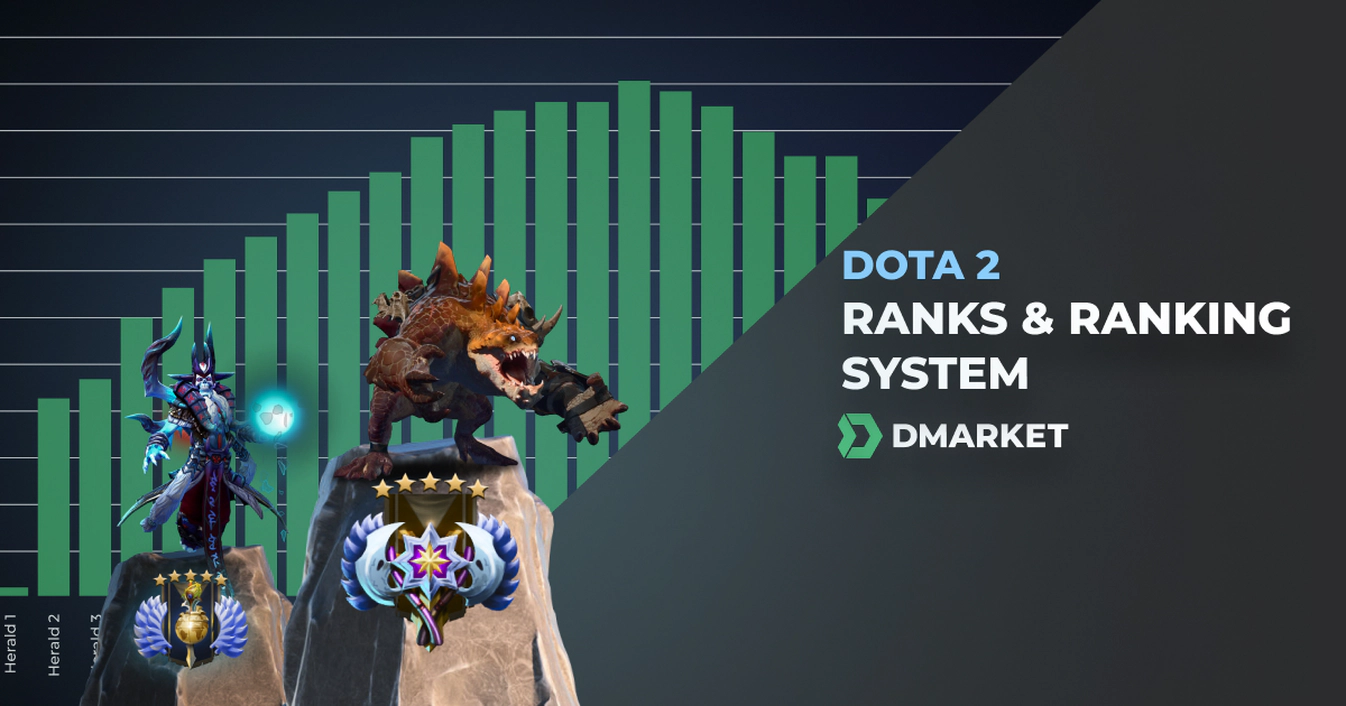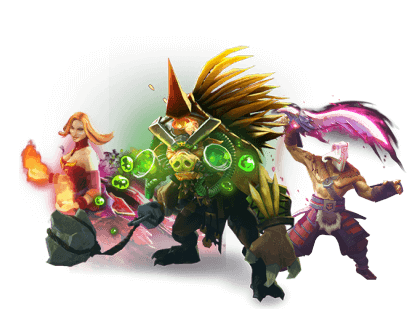Dota 2 Ranks, MMR, Distribution and Tips to Increase Your Dota 2 Rank
Dota 2 ranks are essential in ensuring that players are matched to games appropriate for their skill level. Of course, that’s not why you’ve arrived at this section on Dota 2 ranks. You’re probably wondering how many matchmaking rank points (MMR) you still need to reach your next Dota 2 rank. Rest assured, we have covered every nook and cranny of Dota ranks here.
How Does Dota 2 Ranking System Work?
Understanding the Dota 2 ranking system is crucial for experienced players looking to improve their standing or simply to comprehend how their skills are being evaluated. This system is more than just a measure of win-loss records; it’s a reflection of a player’s ability to influence the outcome of a game positively.
-
Matchmaking Rating (MMR): At the heart of the ranking system is the Matchmaking Rating (MMR), a numerical score that represents a player’s skill level. Your MMR changes after each match, increasing with a win and decreasing with a loss. The amount of MMR gained or lost depends on several factors, such as the MMR of your opponents and the expected outcome of the match.
-
Calibration Matches: New accounts undergo a series of calibration matches to determine their initial MMR. For experienced players, recalibration happens at the start of each ranked season, adjusting their MMR to reflect their current skill level.
-
Core and Support MMR: Dota 2 differentiates between Core and Support MMR. This reflects a player’s proficiency in these two broad roles. Your performance in matches where you play core roles (carry, mid-lane) affects your Core MMR, while support roles (off-lane, soft support, hard support) influence your Support MMR.
-
The Medal System: Dota 2 ranks are visually represented by medals, ranging from Herald to Immortal. Each medal is further divided into five tiers, denoted by stars. Your medal represents the higher of your two MMRs (Core or Support), and it provides a more static representation of your skill level, not decreasing for losing streaks within a season.
-
Immortal Rank: The topmost rank, Immortal, is unique. It’s solely based on a player’s MMR and not divided into Core and Support. The best of the best are placed in a regional leaderboard, making it a prestigious and highly competitive rank.
-
Party and Solo MMR: Historically, Dota 2 had separate MMRs for Solo and Party games, but this was changed to unify the ranking experience. Now, playing with a party can influence your individual MMR, with adjustments in place to account for the advantages of coordinated team play.
-
Behavior Score: While not directly affecting your rank, the behavior score, which tracks your conduct in games, can influence your matchmaking experience. Higher behavior scores lead to being matched with similarly well-behaved players, potentially impacting game quality and outcomes.
What Are Dota 2 Ranks?
In Dota 2, the ranking system is a way to gauge a player’s skill level and progression through competitive play. It’s a hierarchy that spans from the novice to the elite, reflecting both skill and dedication.
Each rank, except Immortal, is further subdivided into five tiers, adding granularity to the progression. The Immortal rank has its own leaderboard, showcasing the best players in each region.
For experienced players, climbing this ladder is more than just about winning games. It’s about mastering nuances, adapting to the constantly evolving meta, and understanding the deeper layers of strategy that Dota 2 offers. Whether you’re pushing for a higher rank or refining your skills in your current tier, each rank offers unique challenges and learning opportunities.
Dota 2 Ranks
In the fifth ranking season, Valve changed matchmaking and recalculated the MMR required to reach all ranks.
Here is the list of all Dota 2 ranks and their MMR:
Herald — 0-769 MMR
The foundation of the ranked ladder. Here, players are still grasping the basics. Positioning, last-hitting, and basic understanding of heroes are key focus areas.
- Herald 1 — 0 MMR
- Herald 2 — 154 MMR
- Herald 3 — 308 MMR
- Herald 4 — 462 MMR
- Herald 5 — 616 MMR
Guardian — 770-1539 MMR
A step above Herald. Guardians are expected to have a firm grasp of the basics and start developing game sense, like map awareness and rudimentary tactical understanding.
- Guardian 1 — 770 MMR
- Guardian 2 — 924 MMR
- Guardian 3 — 1078 MMR
- Guardian 4 — 1232 MMR
- Guardian 5 — 1386 MMR
Crusader — 1540-2309 MMR
The middle ground of the ranking system. Crusaders should have a solid understanding of most game mechanics and begin to refine their skills in specific roles or with certain heroes.
- Crusader 1 — 1540 MMR
- Crusader 2 — 1694 MMR
- Crusader 3 — 1848 MMR
- Crusader 4 — 2002 MMR
- Crusader 5 — 2156 MMR
Archon — 2310-3079 MMR
A respectable rank where players demonstrate proficiency in various aspects of the game. Archons often have good hero knowledge, can execute more complex strategies, and understand the importance of objectives.
- Archon 1 — 2310 MMR
- Archon 2 — 2464 MMR
- Archon 3 — 2618 MMR
- Archon 4 — 2772 MMR
- Archon 5 — 2926 MMR
Legend — 3080-3849 MMR
This hrank that separates the dedicated from the casual. Legends exhibit strong strategic play, effective communication, and the ability to adapt to the evolving nature of each match.
- Legend 1 — 3080 MMR
- Legend 2 — 3234 MMR
- Legend 3 — 3388 MMR
- Legend 4 — 3542 MMR
- Legend 5 — 3696 MMR
Ancient — 3850-4619 MMR
Here, the competition starts getting fierce. Ancients have a strong grasp of advanced mechanics, drafting strategies, and can consistently perform well in their chosen roles.
- Ancient 1 — 3850 MMR
- Ancient 2 — 4004 MMR
- Ancient 3 — 4158 MMR
- Ancient 4 — 4312 MMR
- Ancient 5 — 4466 MMR
Divine — 4620-5420 MMR
The lower echelons of the elite, Divines demonstrate near-professional levels of play. This includes deep understanding of minute game details, exceptional mechanical skills, and the ability to read and control the game flow.
- Divine 1 — 4620 MMR
- Divine 2 — 4820 MMR
- Divine 3 — 5020 MMR
- Divine 4 — 5220 MMR
- Divine 5 — 5420 MMR
Immortal — 5620+ MMR
The pinnacle of Dota 2’s ranking system. Immortals are the crème de la crème, often including professional players. This rank demands exceptional skill, strategic acumen, and almost flawless execution.
What Is MMR in Dota 2?
A player’s matchmaking rating (MMR) has always determined a player’s Dota 2 ranking. The concept is straightforward: a player receives or loses 30 MMR for each solo victory or loss, and 20 MMR for each party win or loss.
Behind the scenes, all is still the same. It has, however, been simplified over time to be more in line with the rank tier systems used in other competitive games such as League of Legends and Overwatch. But if you are here, it probably means that you prefer Dota 2 over LOL. If that’s the case and you are a Dota 2 fan, feel free to check out and download the best Dota 2 wallpapers for your PC.
How to Check Your MMR in Dota 2?
- Start by opening the main menu once you’re in the game
- Navigate to and select your profile
- From there, click on the “Stats” section
- You’ll find your MMR displayed prominently in the upper right corner of the Stats page.
Dota 2 Ranks Distribution
Achieving a high rank in a game like Dota 2 requires much attention and work, but it is doable for anyone.
Dota 2 rank distribution shows you how skilled you are in the game and how distant you are from the average player. This system ensures that players are matched against others of similar capability, fostering competitive and balanced gameplay. The distribution tends to be pyramid-shaped, with the majority of players populating the lower and middle ranks, and fewer reaching the upper echelons of Immortal.

Below you can see the percentile of all ranks in Dota 2:
| Rank | Percentile | Rank | Percentile |
|---|---|---|---|
| Herald 1 | 0.06% | Archon 4 | 4.38% |
| Herald 2 | 1.37% | Archon 5 | 4.10% |
| Herald 3 | 1.58% | Legend 1 | 4.04% |
| Herald 4 | 2.04% | Legend 2 | 3.61% |
| Herald 5 | 2.30% | Legend 3 | 3.24% |
| Guardian 1 | 2.58% | Legend 4 | 2.87% |
| Guardian 2 | 2.83% | Legend 5 | 2.55% |
| Guardian 3 | 3.14% | Ancient 1 | 2.47% |
| Guardian 4 | 3.41% | Ancient 2 | 2.07% |
| Guardian 5 | 3.72% | Ancient 3 | 1.72% |
| Crusader 1 | 4.13% | Ancient 4 | 1.44% |
| Crusader 2 | 4.35% | Ancient 5 | 1.24% |
| Crusader 3 | 4.57% | Divine 1 | 1.40% |
| Crusader 4 | 4.70% | Divine 2 | 1.11% |
| Crusader 5 | 4.74% | Divine 3 | 0.86% |
| Archon 1 | 4.90% | Divine 4 | 0.66% |
| Archon 2 | 4.77% | Divine 5 | 0.55% |
| Archon 3 | 4.60% | Immortal | 1.91% |
Your performance determines your seasonal rating during the current season. These rankings are only available in ranked matches during that season and will be reset when the next one begins. Remember that additional criteria determine your season ranks that aren’t entirely dependent on MMR. It also can depend on how many people play Dota 2 as Valve tries to keep a certain percentage of players in certain ranks.
How to Increase Rank in Dota 2?
Ranking up in Dota 2 demands a mix of skill, strategy, and mindset. Here are the tips encompassing various aspects to help you climb the ranks effectively:
-
Master the fundamentals. Regardless of your current rank, reinforcing the basics is pivotal. This includes last-hitting, understanding hero roles, itemization, and map awareness. For beginners, focus on getting comfortable with a few heroes and their abilities. Experienced players should refine these skills to perfection.
-
Know the roles. While specializing in a role or a few heroes can be beneficial, versatility is also key. Knowing how to play multiple roles and a variety of heroes makes you adaptable in various team compositions and against different opponents.
-
Map awareness and vision control. The importance of vision in Dota 2 cannot be overstated. Regularly check the minimap for enemy movements and ensure your team maintains good vision with wards. Denying the enemy vision is equally crucial. This tip is vital for all levels of play.
-
Communication and teamwork. Dota 2 is a team game. Effective communication can be the difference between victory and defeat. Use pings, chat, and voice communication to coordinate with your team. Remember, positive communication fosters better teamwork.
-
Efficient farming and resource utilization. Efficient farming is not just for the carry. Every role should understand how to maximize resource gathering, including supports through pulls and stacks. Higher-ranked players should focus on advanced techniques like farming patterns and efficient jungle rotations.
-
Analyze every game. Post-game analysis is a powerful tool. Review your games, especially losses, to understand what went wrong and what could be done better. For advanced players, studying professional games can provide deep insights into strategic choices and item builds.
-
Stay tuned for updates. The Dota 2 meta is ever-evolving. Keeping up-to-date with the latest patches and understanding how they affect the game is vital. Adapting your hero pool and strategies according to the meta is a hallmark of a high-ranking player.
-
Regular practice and consistency. Regular gameplay is key to maintaining and improving skills. Set a consistent practice schedule and stick to it. This is essential for players at all levels.
Right from the start, the road is not easy. However, this can distinguish individuals ready to learn the game and work harder to get into the ranked mode. If you are one of those individuals, you can also buy Dota 2 items and equip your heroes with the best skins you can find.
The Dota 2 ranking system can be complicated for novice players, but we’ve done our best to make it simple for you. That’s all there is to the Dota 2 ranking system. Don’t forget to check the best Dota 2 heroes to play. If you prefer CS2, check the updated information regarding CS2 ranks and rating system in our post.
Trade on the go - install the mobile app of DMarket from Google Play or App Store. Never miss great prices and unique skins. The best CS2, Dota 2, Rust and TF2 marketplace is always at hand!


Follow us on Facebook and Twitter to get more interesting articles about Dota 2!























